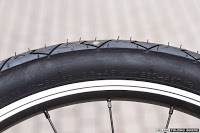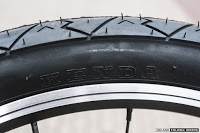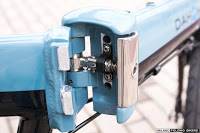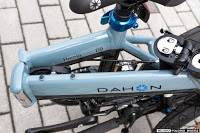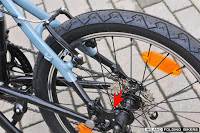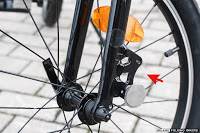
21 Jun DAHON Hemingway D9 Review by Milano Folding Bikers
The Milano Folding Bikers recently reviewed the DAHON Hemingway D9, see what they had to say about the bike…
‘We tried the Dahon Hemingway D9, a new model of the famous Californian house. At first glance, the general aesthetic reminds a bit of the previous Jetstream and Jet, with the fundamental difference of having neither front nor rear suspensions.
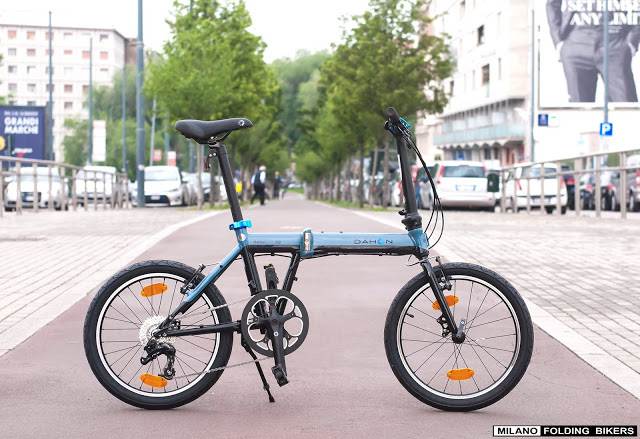
Frame and fork are aluminum, with central fold, V-Clamp central joint, steering column not adjustable in height and predispositions for mounting mudguards, bottle cages, rear rack, third wheel (Dahon Landing Gear) for passive transport and front loading bracket (KlickFix or similar), whose grafting holes are covered by a plate with the coat of arms of the house held by a 3 mm Allen screw solution not only elegant but also interesting because perfectly reversible, unlike the adhesive cover or with rubber plugs that we are used to seeing on other bikes.

The rear carriage of the Dahon Hemingway D9 has a width between the dropouts (OLD) of 135 mm.
Under the seat post securing collar you notice an adhesive with a scratch area under which we imagine there is a unique code for the warranty registration on the manufacturer’s site.
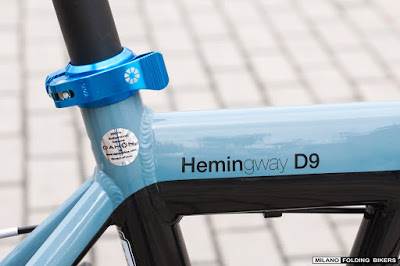
The general appearance is less stringent than other folds of the same category, with the main beam of the high and almost perfectly horizontal frame; at first glance you may have the impression of a “short” bike, but then, meter in hand, it turns out with some surprise that the measures of pitch and total length (102 and 153 cm respectively) are identical to classic models like Vitesse and Speed. Interesting triangular space above the central movement, which lends itself well to be used to insert a tool bag.
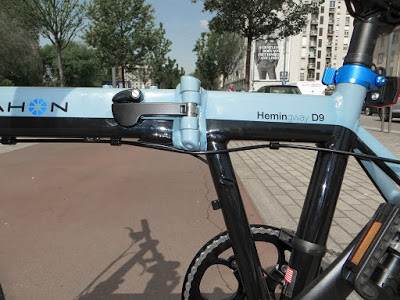
The cables are external, maybe not elegant but certainly much more practical than those inside the frame.
The manufacturer declares a mass of 12.3 kg and the value seemed to us to be fully reliable.
The bike of our test was equipped with reflectors only on the back and on the wheels, then still to be completed to be made “code”.
Currently available colors are two: light blue / black as in our test bike and dark red / dark gray. The satin black finish of the steering column and the seat post tube is very elegant, but it must be checked over time.
THE HANDLEBAR
The handlebar is almost straight, 56 cm wide, and has a diameter of 25.5 mm at the center and 22.3 mm at the knobs; it is mounted on a non-adjustable 315 mm long column that determines a height from the ground of 97 cm, suitable for a trim neither too sporty nor too touristy for people of average build (the house indicates a maximum height of 1.90 m and a weight 105 kg).
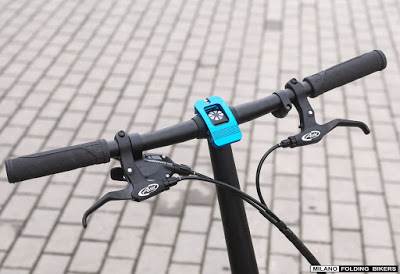
Can be unlocked with the eccentric lever (with spring-loaded safety lock) and rotated to adjust the ideal angle of the brake levers and to place them down before the bend.

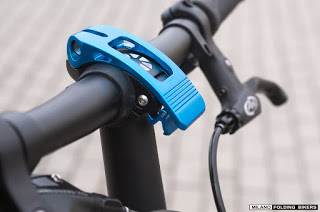
The Ergo Comfort knobs have a slightly worn look and are made of hard but not stiff rubber, without palmtop support; the comfort over long distances remains unknown.
The SRAM X5 gear selector levers are located under the right hand rotary control, which are practical for use but without an engaged gear indicator.
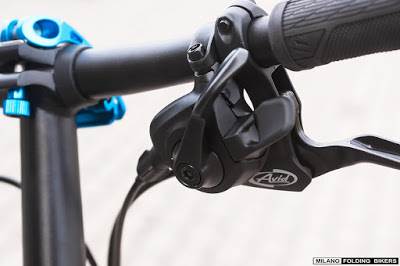
THE BRAKING SYSTEM
The brakes are 110 mm V-brakes, driven by AVID levers with the classic “three-finger” grip and wire tension regulators.
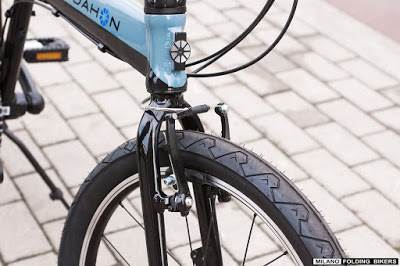 THE WHEELS
THE WHEELS
The wheels are 20″, with double-walled aluminum rims with a matte black finish, the front with 20 spokes, the rear with 28 spokes, both with quick release, a fineness that, however, does not seem essential and could be even counterproductive if you were to leave your bike unattended outdoors.
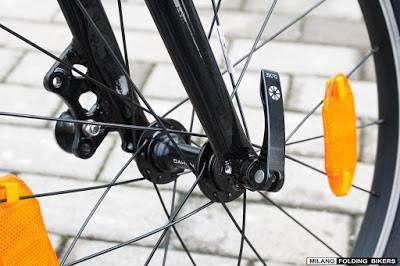
As standard, the Kenda tires are 20×1.95 and look a little cheap, with inflation pressure between 2.8 and 4.6 bar.
The width of the rear wagon and fork at the height of the tires (about 70 mm) suggests that even wider tires like the 2.15 “Big Apple can be mounted without too much difficulty.
THE TRANSMISSION
The single crown, screwed on the central “spider” and therefore easily replaceable, has 53 teeth and …
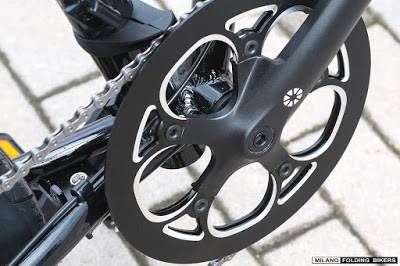
… the sprockets with the sequence of 11-12-14-16-18-21-24-28-32 teeth, determine a metric development (distance traveled for each crank revolution) between 2.53 m with the ratio shorter and 7.37 m with the longer one (calculated on the basis of a circumference of the measured wheel rolling surface of 153 cm).
The derailleur is a SRAM X5, with a short cage.
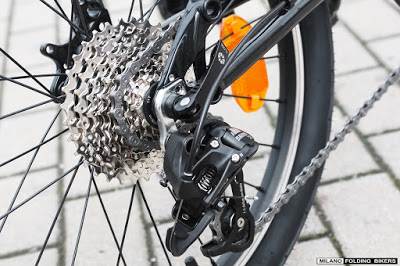
THE SADDLE
The standard-fitted saddle looks quite cheap but has nevertheless proved very comfortable from the first approach.
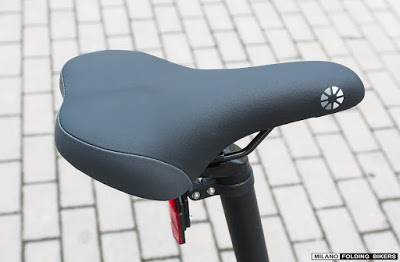
In the detail view you can see the fixing clip and the saddle rails without impressing the graduated scale for fine adjustment.
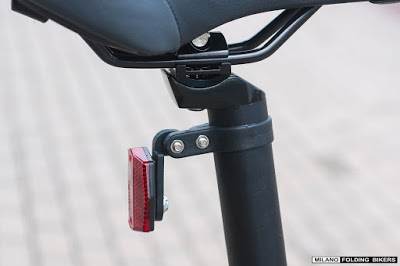
Even the seatpost tube, measuring 33.9 mm in diameter by 580 mm in length, does not have a graduated scale for precision height adjustment.
THE JOINTS
The hinge at the base of the column, placed at 65 cm from the ground, is the classic one of most Dahon models, with a solid and well-finished look, with a butterfly safety lock with spring return.
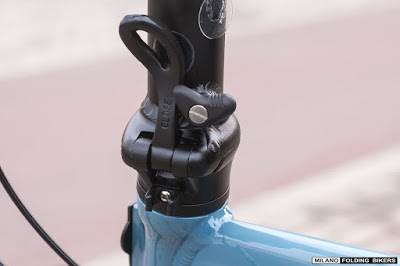
In the open position the lever remains locked in a small fork.

The V-Clamp central joint, very solid in appearance, has the release lever (with spring-loaded safety catch) that bends the bike inside the joint.
PEDALS
The pedals are foldable, equipped with reflectors, and are released by pushing them towards the hub.
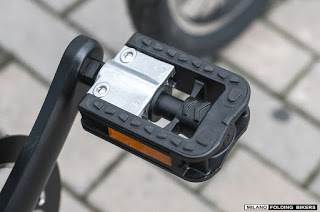
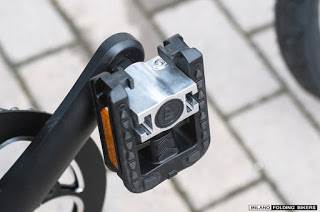
THE STAND
The side stand is adjustable in length, a particularity not necessary for this bike but probably adopted for the purpose of rationalizing the components within the Dahon range, so that it can also be applied on different types of bikes.
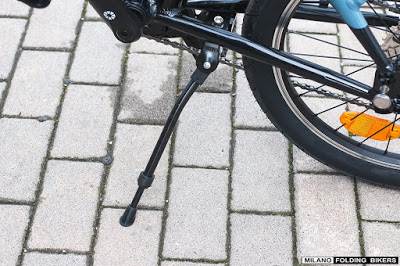
THE MUDGUARDS
The mudguards are not fitted as standard, but there are relative connections on the frame.
THE BENDING SYSTEM
The folding sequence of the Hemingway is the usual one of all the folds with central joint, with the handlebars inside the half-frames, to the advantage of compactness; since the space for the handlebar between the two half-frames is quite counted, before tearing down the steering column you have to turn the handlebars by placing it with the train levers downwards, so as to make it as “thin” as possible; more than many words, our video exemplifies operations and their sequence.


Here’s how the bike is closed: on the manufacturer’s website the declared dimensions are 79x65x32 cm, not very far from the 86x69x39 cm detected by us.
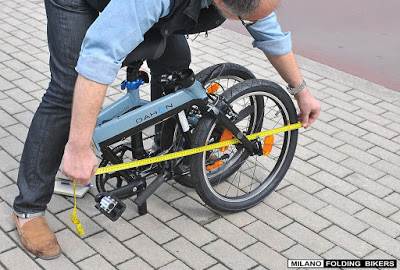
PASSIVE TRANSPORT
Once closed, the Hemingway can be transported in the two classic “pull” and “push” modes , in both cases with a better stability than most of the central fold bikes, thanks to the wheels that are arranged well parallel and almost perfectly aligned. However, the magnets tend to disengage quite easily, compromising stability.


ON THE ROAD
Once in the saddle, the Dahon Hemingway D9 shows a bright character; the rigid frame causes the power to drain well to the ground and the longer ratios allow you to reach good speeds (provided you have the leg to push them …); the position in the saddle is natural and the rigidity of the frame entices the shot and some saddles. There are no signs of bending even in the most determined braking. To compensate for a bit ‘we think the tires “cicciotte” that collect rather well the roughness.
The guide is precise and agile, but it is not advisable to try the “without hands”.
CONCLUSIONS
The Dahon Hemingway D9 has two contrasting aspects: a well-designed chassis and a good-quality gearbox are combined with other components (knobs, saddles, pedals and tires) from the cheaper air, probably chosen to contain the final price (849 euro list).
While carefully observing the details of this bike, we discovered the settings (see red arrows in the picture) for mounting the front and rear disc brakes and for a central derailleur (do not forget the removable crank)
All this suggests that in the future a “rich” version with a higher range will also be available.
As it is now, the Dahon Hemingway D9 appears an interesting compromise: sporty but not exasperated and usable even daily by commuter. The stiffness of the frame and the sturdy central joint ensure a good peace of mind even on “difficult” pavements such as pavé and the basolato of Milan and certainly allow to easily tackle even some not too demanding dirt roads.
A thank you goes to the friends of the shop “La Stazione delle Biciclette” who gave us the test for the Dahon Hemingway D9.
And, finally, the two testers who have tried for you the Hemingway, strictly in order of age …’
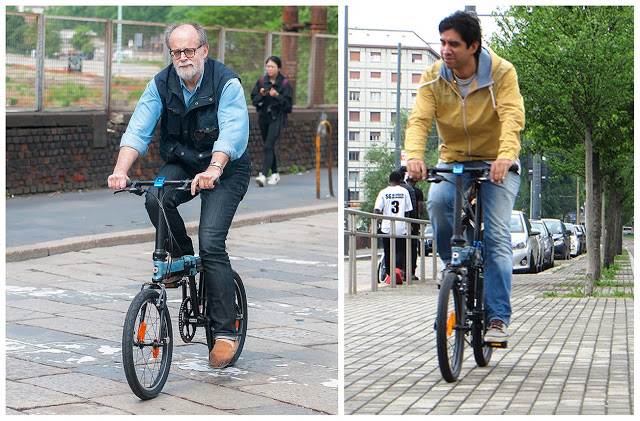
Thanks to Milano Folding Bikers for this awesome review! Check out the original post over on their website and be sure to take a browse through the website whilst you are there to read some of their other reviews.




